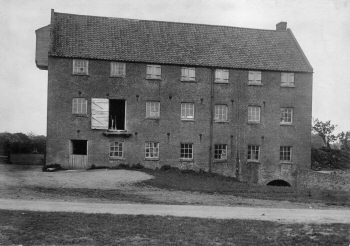 |
|
c.
1935
|
|
West Newton Mill
River Babingley |
 |
|
c.
1935
|
|
West Newton watermill has throughout history, often been mistaken for or referred to as Castle_Rising watermill, whereas they are separate mills, although they are in the same parish. At some point the river course was altered in order to provide the necessary head of water to power the mill and the parish boundary line almost certainly indicates the original course. The mill was
constructed of brick under a Norfolk pantiled roof, although some materails almost certainly came from Castle Acre Priory. Although the first
known mention of the mill in 1588 relates to a fulling mill, West Newton
was best known after the fulling mill had been converted to a paper mill
and was actually the subject of the first reference to a paper mill in
Norfolk. For many years the mill was in the estate of the Viscount of
Andover - the Howard family. |
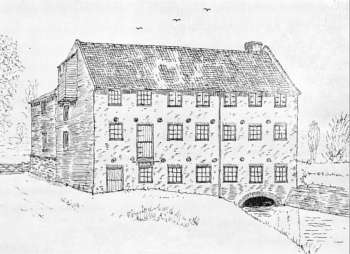 |
|
Claude
Messent's drawing of July 1938
|
 |
 |
|
Mill
dam June 1946
|
Mill dam 18th January 2004 |
 |
 |
|
1950s
|
June 1968 |
|
A deed in the archive of the Howard family of Castle Rising dated 11th May 1695 refers to a fulling mill converted to a paper-mill. Then in 1707 there is mention of Herbedge for ground at ye paper Mill. In 1711 it was recorded that William Goodale, a journeyman papermaker had died. Another deed from the Howard archive states that from 20th November 1713 John Holdsworth of Castle Rising, paper-maker, rented 'all the paper mill situate lying and being in (Castle Rising with all gardens, waters, streams of water passages, ways and appurtenances' for £14 10s. per annum. |
 |
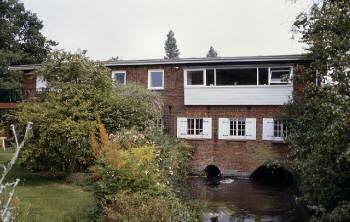 |
June 1968 |
June 1983 |
|
The mill was
at work until 1722, when the paper-maker had a serious dispute with the
neighbouring corn-miller on the estate. The Norwich Gazette for 21st July
of this year reported 'Yesterday were committed to the Castel one Jeremy Holmes of Castlerising and Richard Gibson his servant, both millers for firing a Paper-mill in the said Borough'. Apparently the cause of the dispute was that the paper-mill had been used
for grinding corn. No more details were given and the fate of the millers
is unknown, except that five years later the paper-mill was still in ruins
and Holmes was no longer the corn-miller. In 1727 Thomas Stirke of Perio
Paper Mill in the parish of Southwick, Northamptonshire leased both Holmes'
corn mill and the adjoining ruined paper-mill together with all rights
and privileges for an annual rent of £21. |
|
The Mad
and Frantick Miller of Castle Rising And upon the occasion I must beg leave to tell your Lordship that I have very great reason to complain of this man's behaviour and ill treatment not only in propagating these false and scandalous Aspertions and abusing me wherever he goes But also in the Great trouble he gives me to pay their rents. But he did not come near me, and whenever I go ask him for the rent he is full of complaints but will hear no reason. His son a Paper maker a sober and industrious young man told me that if his father would let him manage, the business could maintain the family well and save money, but he believed they should all be ruined by his father for the Mill was so out of repair that they could not do half the work they otherwise should. But he is so much altered since the Fit of Illness that he has become the worst tenant upon your Lordship's Estate, But in consideration of his Distemper, And in pity for his family, I have always hitherto born with his ill treatment and for Fear of adding to the Poor Wretch's Affliction which is as inconsistent with my Disposition as possible. His poor wife has told me several Times crying that she is weary of her life he is so mad and frantick in the family and his son lately went away from him for the same reason. Alas there is no conclusion to the story of the Mad and Frantick Miller of Castle Rising, for there is no record of the reply of William Howard Viscount Andover. As Richard Fawsett continued in the office of agent, it is reasonable to suppose that he worked out a solution to his problem of his mad and frantick tenant - or perhaps death mercifully removed him from the paper mill. |
The 1795-1832 Howard family archives records - Leases of paper mill on site of fulling mill, water corn mill, and farm at Castle Rising. The Mill was leased to John Lewis for 21 years at £30 p.a ‘late in the occupation of Richard Newman.' |
In 1832 the mill was leased to Richad Munn for 15 years at a rent of £100 p.a. The inventory included |
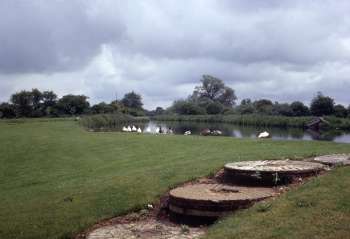 |
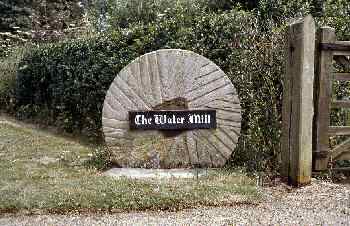 |
Millstone steps June 1968 |
Mill gate June 1983 |
INSURANCE POLICY FOR CASTLE RISING MILLS 1868 |
Between Norwich Union Fire Insurance Society and the Hon Mary G Howard (widow) |
|
One of the
garden paths consists of 5 old millstones. |
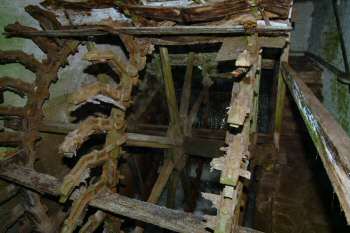 |
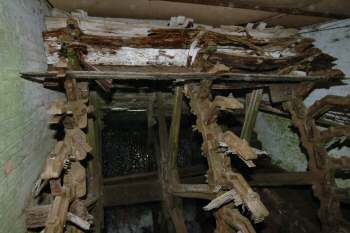 |
|
Wheel remains 18th January 2004
|
Wheel
paddles 18th January 2004 |
 |
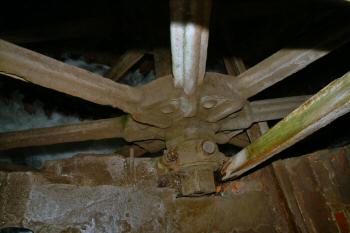 |
|
Wheelrace 18th January 2004
|
Wheel
bearing 18th January 2004 |
|
The remaining wheel sluice configuration along with a pair of empty wall slots appears to indicate that the wheel could be either breastshot or undershot in a similar way to Letheringsett mill. A dual irrigation system was of good use in times of water shortage and West Newton mill site was relatively close to the spring fed river source. |
 |
|
Mill
dam 18th January 2004
|
|
When Mr. &
Mrs. G. V. Whitehouse bought the mill in 1965 the structure contained considerable
amounts of dry and wet rot along with much beetle damage. |
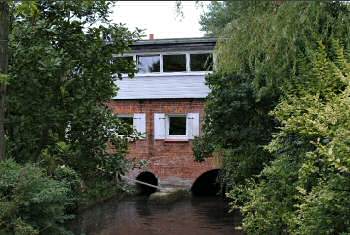 |
 |
|
24th August 2003
|
Tailrace
arches 18th January 2004 |
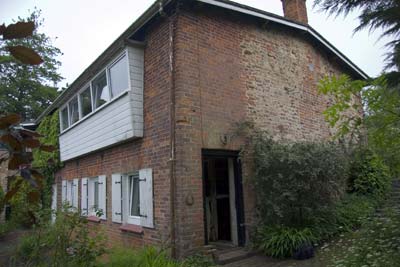 |
Wheelhouse door 11th June 2007 |
Evidence of an earlier attached building can clearly be seen on the gable end of the mill. |
Converted water mill in West Newton dating back to 1588 |
A converted water mill featuring its original wheelhouse set on the edge of the royal Sandringham estate is on the market for just over £1million. |
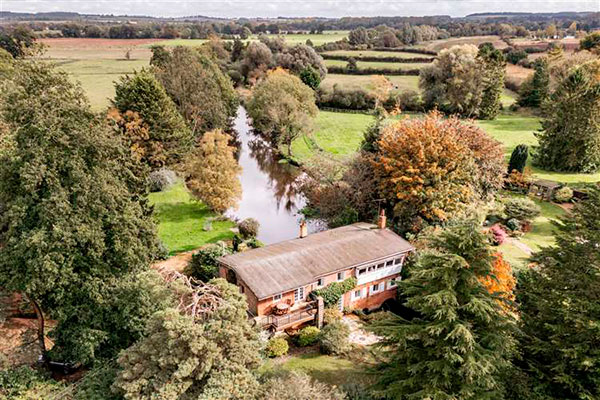 |
The Watermill also boasts direct views of the mill pond and river from the comfort of the house - the main part of which is more than 3,000 square feet, including the original wheelhouse. |
 |
 |
Hillington Estate map 1756 showing West Newton Mill |
|
On the other side of Flitcham (from the Priory), where
the road runs over it, the Babingley River flows secretly through a growth
of dead loosestrife, agrimony and brambles, but near the disused flax
factory, further west it is clear and wide. 'No Fishing' reads the notice,
near the old mill house, which is now adapted for modern usage. There
is a fine millpond behind, for though the Babingley may be a humble stream,
its power was enough to turn the wheels of industry before other mechanical
devices were available. |
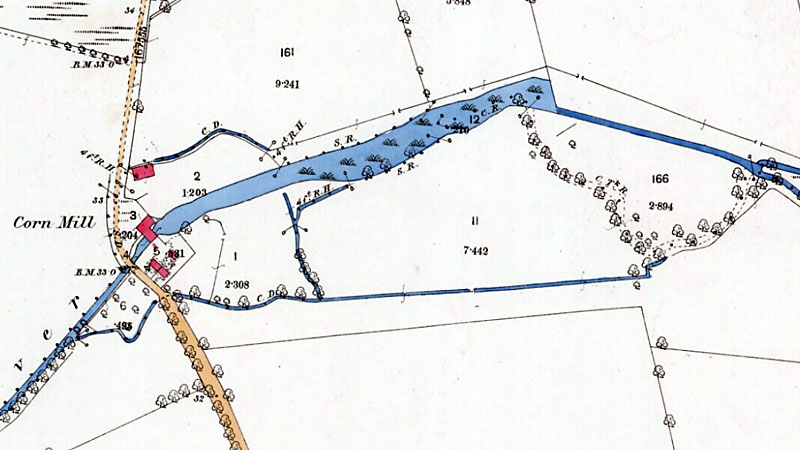 |
O. S. Map 1884 |
The above map clearly shows the dotted line of the parish boundaries that traced the original path of the river, which was altered in order to to accommodate the mill and the mill dam. A now completely dried up southern meander on the upstream side was bypassed by a new and straight cut leading to what became the mill dam.
|
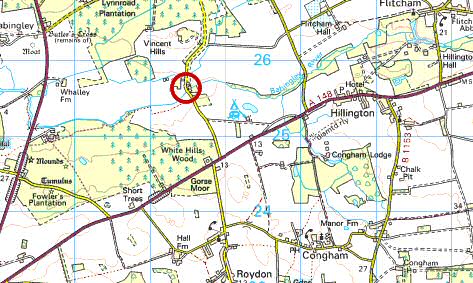 |
O.S. Map 2005 Image reproduced under licence from Ordnance Survey |
c.1954: Mr. Snelling, a forage dealer moved to the mill with his wife, sons David and Michael and daughter Barbara. |
|
Map 1588: Map of Rising Chase shows two mills, Rising Corn Mill (Castle Rising) and Rysinge Fulling Mill Kelly's 1896: Fernley Knight, farmer & miller (water), Lodge
Kelly's 1904: Fernley Knight, farmer & miller (water) Lodge |
If you have any memories, anecdotes or photos please let us know and we may be able to use them to update the site. By all means telephone 07836 675369 or
|
| Nat Grid Ref TF6949 2563 | Copyright © Jonathan Neville 2025 |